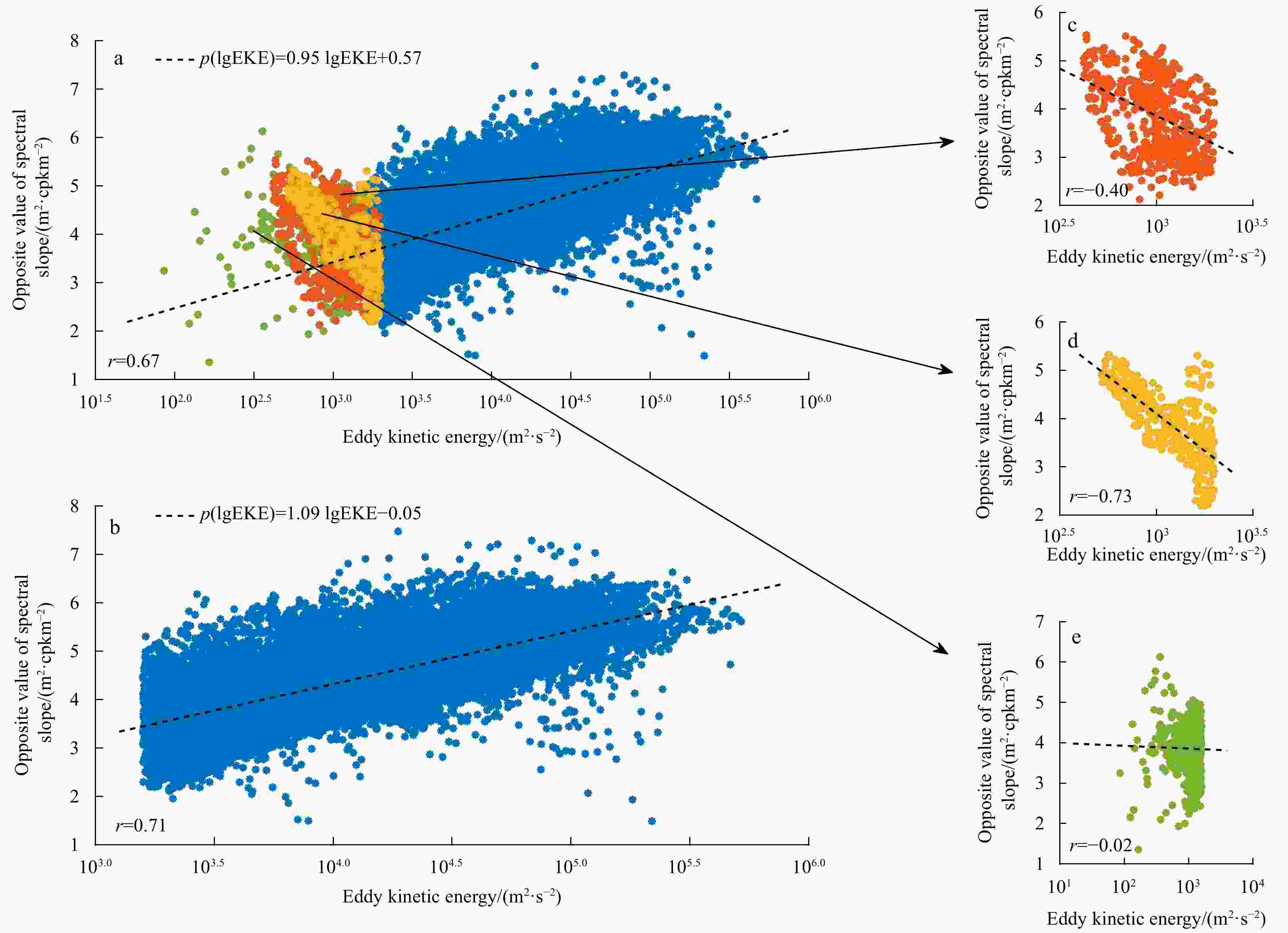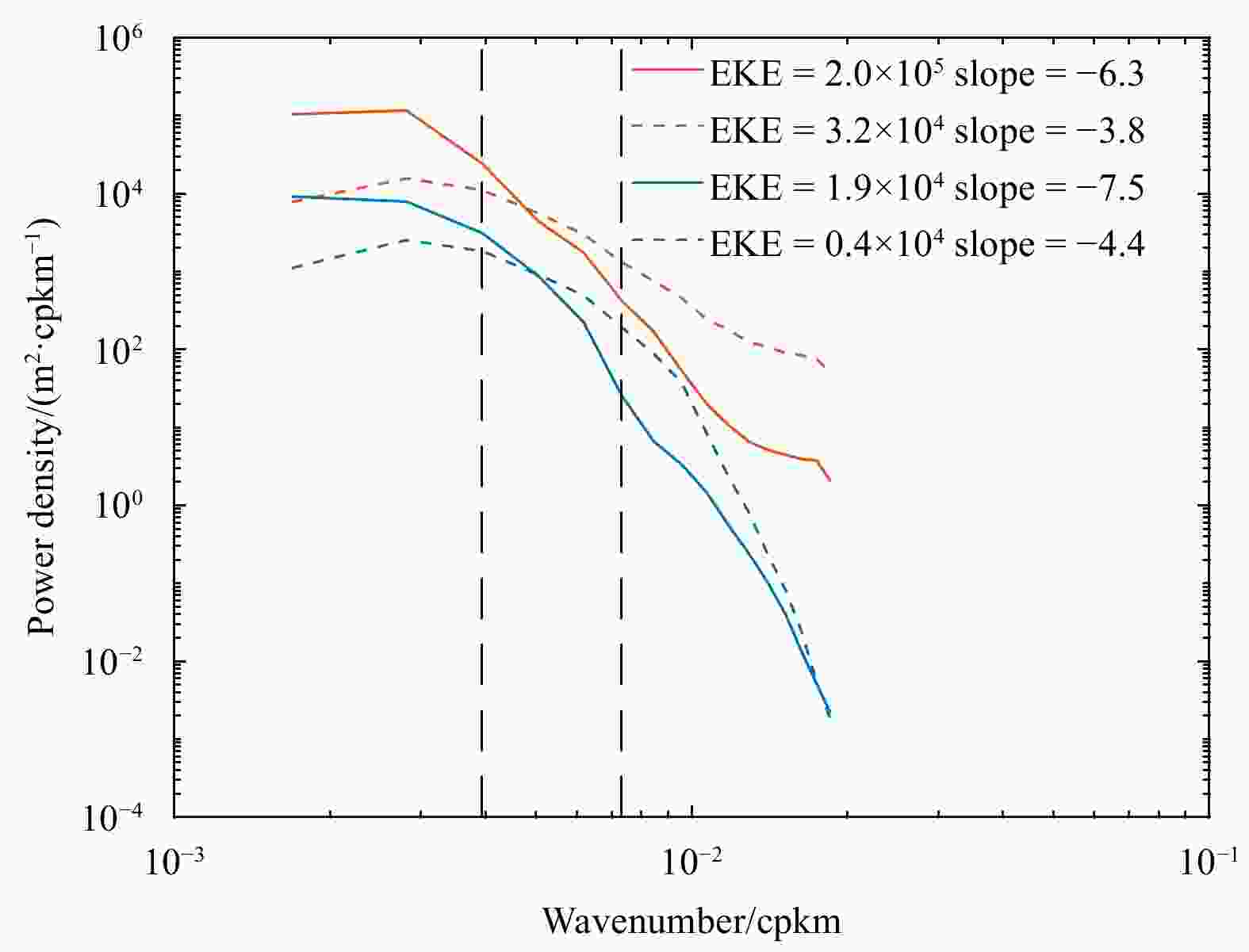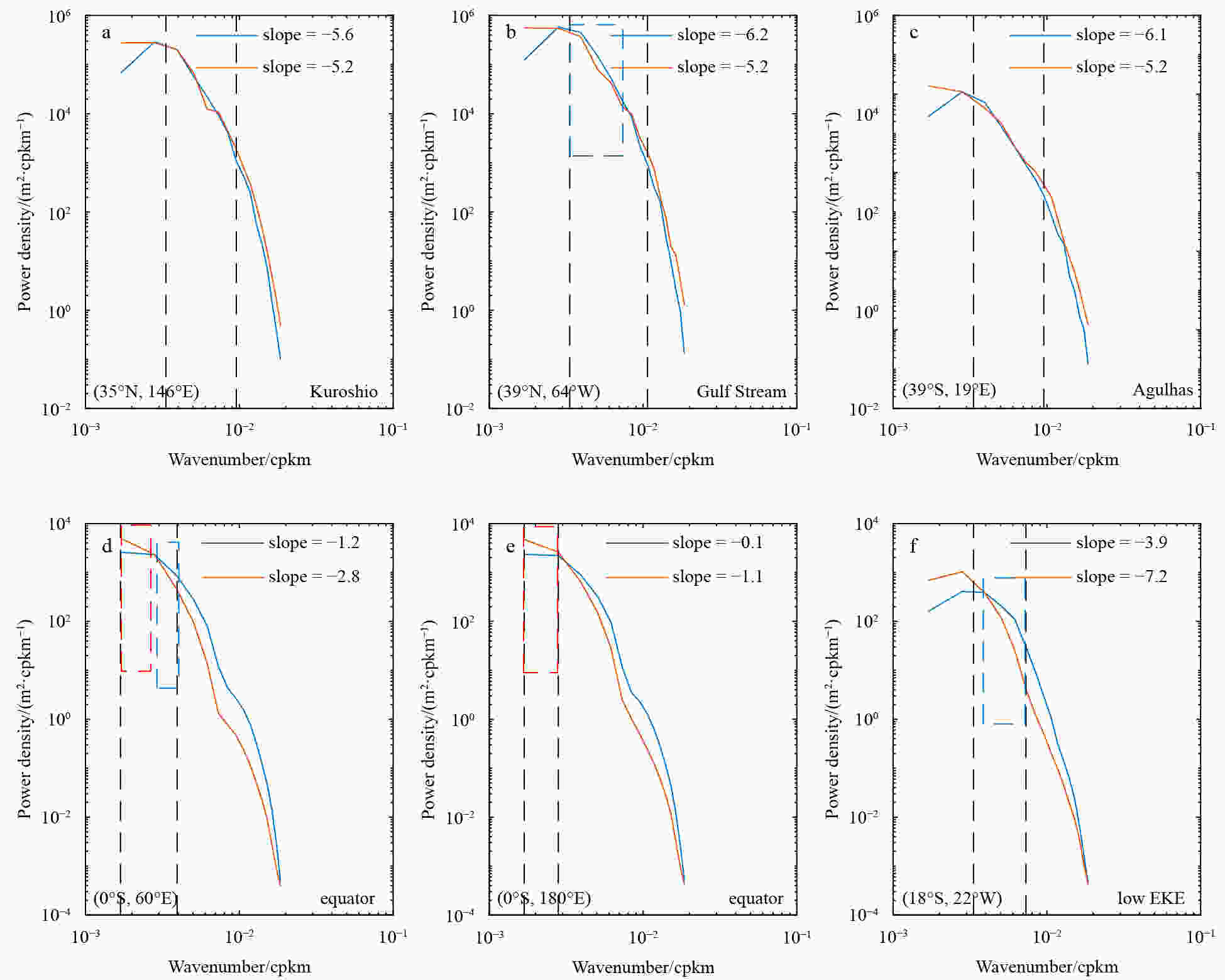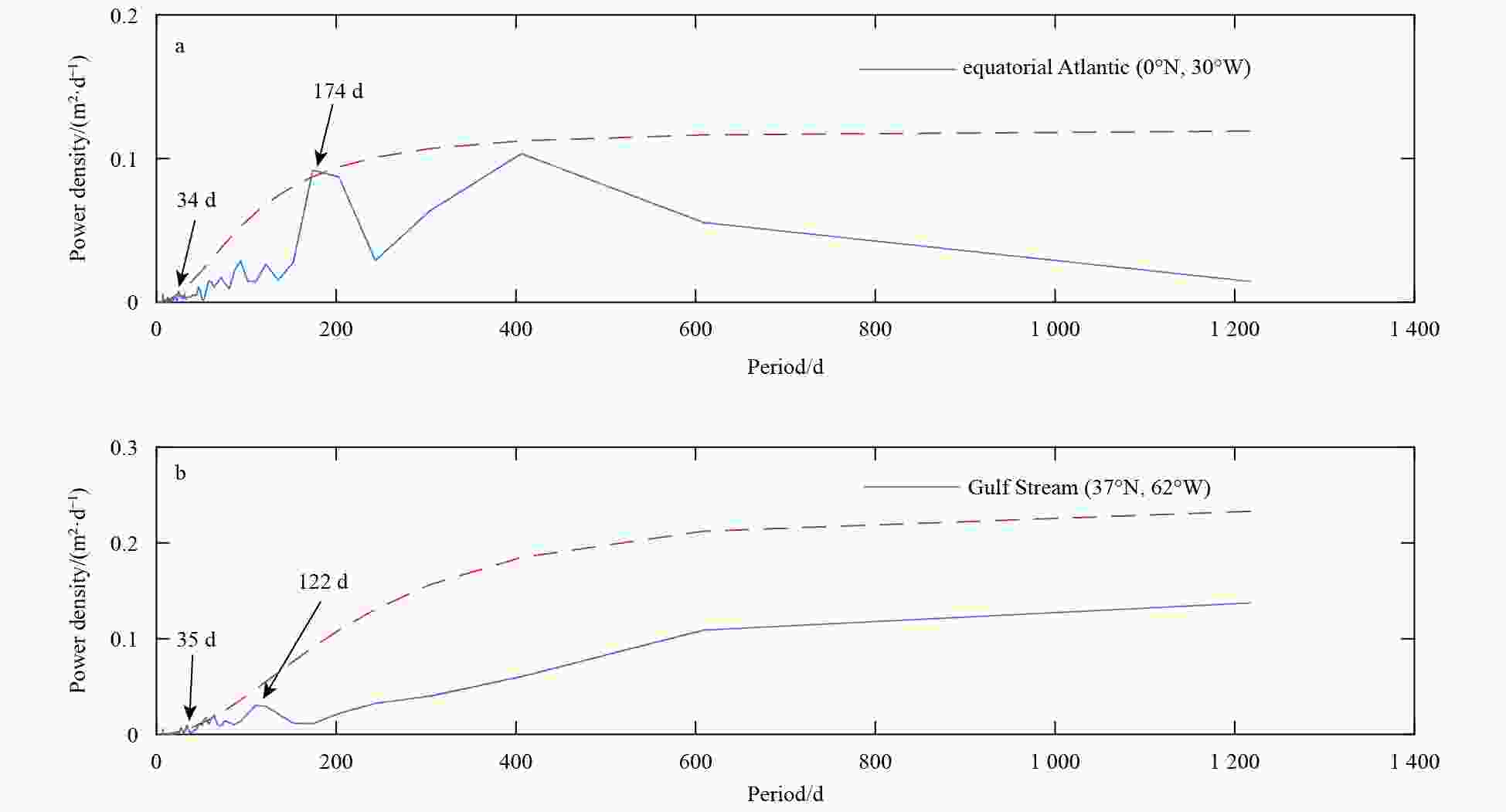Characteristics of oceanic mesoscale variabilities associated with the inverse kinetic energy cascade
-
Abstract: Oceanic geostrophic turbulence theory predicts significant inverse kinetic energy (KE) cascades at scales larger than the energy injection wavelength. However, the characteristics of the mesoscale variabilities associated with the inverse KE cascade in the real oceans have not been clear enough up to now. To further examine this problem, we analyzed the spectral characteristics of the oceanic mesoscale motions over the scales of inverse KE cascades based on high-resolution gridded altimeter data. The applicability of the quasigeostrophic (QG) turbulence theory and the surface quasigeostrophic (SQG) turbulence theory in real oceans is further explored. The results show that the sea surface height (SSH) spectral slope is linearly related to the eddy-kinetic-energy (EKE) level with a high correlation coefficient value of 0.67. The findings also suggest that the QG turbulence theory is an appropriate dynamic framework at the edge of high-EKE regions and that the SQG theory is more suitable in tropical regions and low-EKE regions at mid-high latitudes. New anisotropic characteristics of the inverse KE cascade are also provided. These results indicate that the along-track spectrum used by previous studies cannot reveal the dynamics of the mesoscale variabilities well.
-
Key words:
- mesoscale eddy /
- inverse cascade /
- scalar wavenumber spectrum /
- spectral slope /
- anisotropy
-
Figure 1. Time-averaged scalar spectral KE flux versus the wavenumber in the Kuroshio (centered at 35°N, 144°E), the Gulf Stream (centered at 39°N, 64°W), and the Agulhas (centered at 40°S, 19°E) regions (a); and the percentage of the magnitude of the inverse cascade KE relative to that of the total cascade KE (R, b). In a, the vertical dashed line is Linj, and the vertical dash-dotted line is Lequ. cpkm: cycles per km.
Figure 2. The global distribution of
${\rm{lg(EKE)}} $ . The points marked with arrows are the typical positions selected for subsequent analyses. EI: the equatorial point in the Indian Ocean, KS: Kuroshio, EP: the equatorial point in the Pacific Ocean, GS: Gulf Stream, EA: the equatorial point in the Atlantic Ocean, AS: Agulhas Current, SIL: the low-EKE point in the South Indian Ocean, SPL: the low-EKE point in the South Pacific Ocean, SAL: the low-EKE point in the South Atlantic Ocean.Figure 3. Time-averaged scalar SSH wavenumber spectrum in high-EKE regions (a), equatorial regions (b), and other low-EKE regions (c). The black dotted line indicates wavelengths of 300 km. KS: Kuroshio, GS: Gulf Stream, AS: Agulhas Current, EI: the equatorial point in the Indian Ocean, EP: the equatorial point in the Pacific Ocean, EA: the equatorial point in the Atlantic Ocean, SIL: the low-EKE point in the South Indian Ocean, SPL: the low-EKE point in the South Pacific Ocean, SAL: the low-EKE point in the South Atlantic Ocean. cpkm: cycles per km.
Figure 4. Spatial distribution of the lower limit (Llow, a) and the zonal average of the lower (blue solid) and upper (orange solid) limits of the variable wavelength range used to fit the spectral slope (b). The Rossby deformation scale Lr (blue dash-dot), the energy injection scale Linj (blue dash), and the eddy equilibration scale Lequ (orange dash) used to detect the inverse KE cascade band are shown.
Figure 5. The global distribution of the SSH wavenumber spectral slopes for the inverse KE cascade inertial range. In a, the blue (red) boxes frame the “eddy desert” (subtropical Pacific) regions analyzed in Fig. 6b (Fig. 8); in b, there are three types of areas in terms of the spectral power law. The red color represents regions with spectral slopes following the QG k11/3 power law within the 95% confidence level, and the blue color represents regions with spectral slopes following the SQG k−3 power law. For comparison with the map made by predecessors, the signs of the slopes were reversed to ensure that most values were positive. cpkm: cycles per km.
Figure 6. Time-averaged scalar SSH wavenumber spectra at the Kuroshio centered at (35°N, 146°E) (red solid), the Gulf Stream centered at (39°N, 64°W) (blue solid), the region around the Kuroshio but with a low-EKE level centered at (31°N, 134°E) (red dotted) and the region around the Gulf Stream with a low-EKE level centered at (56°N, 47°W) (blue dotted) (a). Time-averaged scalar SSH wavenumber spectra with the regionally steepest slope (–5.5 and –5.3 respectively) at the “eddy deserts” (marked with blue boxes in Fig. 5a) (solid) and the adjacent regions (dotted). The four regions centered at (48°N, 162°W) (red solid), (42°N, 159°W) (red dotted), (51°S, 101°W) (blue solid), and (46°S, 96°W) (blue solid) (b). The black dotted line indicates the upper and lower limit wavelengths, respectively. cpkm: cycles per km.
Figure 7. Scatter diagram between the EKE order of magnitude and the inverse of the wavenumber spectral slope in the global ocean (a), the global ocean without the “eddy deserts” and areas with an EKE lower than 103.2 m2/s2 (b), the “eddy desert” in the North Pacific (c), the “eddy desert” in the South Pacific (d), and other areas with an EKE lower than 103.2 m2/s2 (e). The dotted line is the first-order fitting for the scatters. cpkm: cycles per km.
Figure 8. Time-averaged scalar SSH wavenumber spectra with the steepest slope (–6.3 and –7.5 respectively) in the eastern subtropical Pacific (solid) (framed with red boxes in Fig. 5a) and adjacent regions (dotted). The four regions are centered at (11°N, 93°W) (red solid), (20°N, 109°W) (red dotted), (11°S, 84°E) (blue solid), and (20°S, 100°W) (blue dotted). The black dotted line indicates the upper and lower limit wavelengths. cpkm: cycles per km.
Figure 10. Zonal (blue) and meridional (red) SSH wavenumber spectra in high-EKE regions (a, b and c), equatorial regions (d and e) and low-EKE regions (f). The black dotted lines indicate the upper and lower limit wavelengths for slope calculation. Obvious anisotropy of the inverse cascade is framed with red (the meridional power density is higher) and blue (the zonal power density is higher) dashed squares.
A2. Time-averaged scalar SSH wavenumber spectra at the equatorial Atlantic Ocean (a) and the Gulf Stream (b) estimated from the data filtered by different methods using 20-a gridded multisatellite measurements. The black dotted lines perpendicular to the x-axis indicate the upper and lower limit wavelengths, respectively.
-
[1] Arbic B K, Flierl G R. 2004. Baroclinically unstable geostrophic turbulence in the limits of strong and weak bottom Ekman friction: application to midocean eddies. Journal of Physical Oceanography, 34(10): 2257–2273. doi: 10.1175/1520-0485(2004)034<2257:BUGTIT>2.0.CO;2 [2] Batchelor G K. 1969. Computation of the energy spectrum in homogeneous two-dimensional turbulence. The Physics of Fluids, 12(12): II-233–II-239 [3] Blumen W. 1978. Uniform potential vorticity flow: part I. Theory of wave interactions and two-dimensional turbulence. Journal of the Atmospheric Sciences, 35(5): 774–783 [4] Bourles B, Molinari R L, Johns E, et al. 1999. Upper layer currents in the western tropical North Atlantic (1989–1991). Journal of Geophysical Research: Oceans, 104(C1): 1361–1375. doi: 10.1029/1998JC900025 [5] Charney J G. 1971. Geostrophic turbulence. Journal of the Atmospheric Sciences, 28(6): 1087–1095. doi: 10.1175/1520-0469(1971)028<1087:GT>2.0.CO;2 [6] Chelton D B, deSzoeke R A, Schlax M G, et al. 1998. Geographical variability of the first baroclinic rossby radius of deformation. Journal of Physical Oceanography, 28(3): 433–460. doi: 10.1175/1520-0485(1998)028<0433:GVOTFB>2.0.CO;2 [7] Chelton D B, Schlax M G, Samelson R M, et al. 2007. Global observations of large oceanic eddies. Geophysical Research Letters, 34(15): L15606 [8] Chelton D B, Schlax M G, Samelson R M. 2011. Global observations of nonlinear mesoscale eddies. Progress in Oceanography, 91(2): 167–216. doi: 10.1016/j.pocean.2011.01.002 [9] Eden C. 2007. Eddy length scales in the North Atlantic Ocean. Journal of Geophysical Research: Oceans, 112(C6): C06004 [10] Ferrari R, Wunsch C. 2009. Ocean circulation kinetic energy: reservoirs, sources, and sinks. Annual Review of Fluid Mechanics, 41: 253–282. doi: 10.1146/annurev.fluid.40.111406.102139 [11] Fu L L. 1983. On the wave number spectrum of oceanic mesoscale variability observed by the SEASAT altimeter. Journal of Geophysical Research: Oceans, 88(C7): 4331–4341. doi: 10.1029/JC088iC07p04331 [12] Fu L L. 2004. Latitudinal and frequency characteristics of the westward propagation of large-scale oceanic variability. Journal of Physical Oceanography, 34(8): 1907–1921. doi: 10.1175/1520-0485(2004)034<1907:LAFCOT>2.0.CO;2 [13] Galperin B, Sukoriansky S, Dikovskaya N. 2010. Geophysical flows with anisotropic turbulence and dispersive waves: flows with a β-effect. Ocean Dynamics, 60(2): 427–441. doi: 10.1007/s10236-010-0278-2 [14] Held I M, Pierrehumbert R T, Garner S T, et al. 1995. Surface quasi-geostrophic dynamics. Journal of Fluid Mechanics, 282: 1–20. doi: 10.1017/S0022112095000012 [15] Jacobs G A, Barron C N, Rhodes R C. 2001. Mesoscale characteristics. Journal of Geophysical Research: Oceans, 106(C9): 19581–19595. doi: 10.1029/2000JC000669 [16] Khatri H, Sukhatme J, Kumar A, et al. 2018. Surface ocean enstrophy, kinetic energy fluxes, and spectra from satellite altimetry. Journal of Geophysical Research: Oceans, 123(5): 3875–3892. doi: 10.1029/2017JC013516 [17] Kobashi F, Kawamura H. 2002. Seasonal variation and instability nature of the North Pacific Subtropical Countercurrent and the Hawaiian Lee Countercurrent. Journal of Geophysical Research: Oceans, 107(C11): 3185. doi: 10.1029/2001JC001225 [18] Kraichnan R H. 1967. Inertial ranges in two-dimensional turbulence. Physics of Fluids, 10(7): 1417–1423. doi: 10.1063/1.1762301 [19] Le Traon P Y, Klein P, Hua B L, et al. 2008. Do altimeter wavenumber spectra agree with the interior or surface quasigeostrophic theory?. Journal of Physical Oceanography, 38(5): 1137–1142. doi: 10.1175/2007JPO3806.1 [20] Le Traon P Y, Nadal F, Ducet N. 1998. An improved mapping method of multisatellite altimeter data. Journal of Atmospheric and Oceanic Technology, 15(2): 522–534. doi: 10.1175/1520-0426(1998)015<0522:AIMMOM>2.0.CO;2 [21] Le Traon P Y, Rouquet M C, Boissier C. 1990. Spatial scales of mesoscale variability in the North Atlantic as deduced from Geosat data. Journal of Geophysical Research: Oceans, 95(C11): 20267–20285. doi: 10.1029/JC095iC11p20267 [22] Leith C E. 1968. Diffusion approximation for two-dimensional turbulence. The Physics of Fluids, 11(3): 671–672 [23] Liu Zhiliang, Pang Chongguang. 2017. The Rhines effect on the geographical characteristics of altimeter-observed eddies. Acta Oceanologica Sinica, 36(9): 10–14. doi: 10.1007/s13131-017-1105-0 [24] Montgomery D C, Peck E A, Vining G G. 2001. Introduction to Linear Regression Analysis. 3rd ed. New York: Wiley [25] Pascual A, Faugère Y, Larnicol G, et al. 2006. Improved description of the ocean mesoscale variability by combining four satellite altimeters. Geophysical Research Letters, 33(2): L02611 [26] Peterson R G, Stramma L. 1991. Upper-level circulation in the South Atlantic Ocean. Progress in Oceanography, 26(1): 1–73. doi: 10.1016/0079-6611(91)90006-8 [27] Pujol M I, Faugère Y, Taburet G, et al. 2016. DUACS DT2014: the new multi-mission altimeter data set reprocessed over 20 years. Ocean Science Discussions, 12(5): 1067–1090. doi: 10.5194/os-12-1067-2016 [28] Qiu Bo, Chen Shuiming. 2004. Seasonal modulations in the eddy field of the South Pacific Ocean. Journal of Physical Oceanography, 34(7): 1515–1527. doi: 10.1175/1520-0485(2004)034<1515:SMITEF>2.0.CO;2 [29] Qiu Bo, Scott R B, Chen Shuiming. 2008. Length scales of eddy generation and nonlinear evolution of the seasonally modulated South Pacific Subtropical Countercurrent. Journal of Physical Oceanography, 38(7): 1515–1528. doi: 10.1175/2007JPO3856.1 [30] Rhines P B. 1975. Waves and turbulence on a beta-plane. Journal of Fluid Mechanics, 69(3): 417–443. doi: 10.1017/S0022112075001504 [31] Rhines P B. 1979. Geostrophic turbulence. Annual Review of Fluid Mechanics, 11: 401–441. doi: 10.1146/annurev.fl.11.010179.002153 [32] Salmon R. 1998. Lectures on Geophysical Fluid Dynamics. New York: Oxford University Press, 378 [33] Scott R B, Wang Faming. 2005. Direct evidence of an oceanic inverse kinetic energy cascade from satellite altimetry. Journal of Physical Oceanography, 35(9): 1650–1666. doi: 10.1175/JPO2771.1 [34] Smith K S. 2007. The geography of linear baroclinic instability in Earth’s oceans. Journal of Marine Research, 65(5): 655–683. doi: 10.1357/002224007783649484 [35] Spall M A. 2000. Generation of strong mesoscale eddies by weak ocean gyres. Journal of Marine Research, 58(1): 97–116. doi: 10.1357/002224000321511214 [36] Stammer D. 1997. Global characteristics of ocean variability estimated from regional TOPEX/Poseidon altimeter measurements. Journal of Physical Oceanography, 27(8): 1743–1769. doi: 10.1175/1520-0485(1997)027<1743:GCOOVE>2.0.CO;2 [37] Stewart R H, Shum C K, Tapley B, et al. 1996. Statistics of geostrophic turbulence in the Southern Ocean from satellite altimetry and numerical models. Physica D: Nonlinear Phenomena, 98(2–4): 599–613 [38] Stewart K D, Spence P, Waterman S, et al. 2015. Anisotropy of eddy variability in the global ocean. Ocean Modelling, 95: 53–65. doi: 10.1016/j.ocemod.2015.09.005 [39] Tchilibou M, Gourdeau L, Morrow R, et al. 2018. Spectral signatures of the tropical Pacific dynamics from model and altimetry: a focus on the meso-/submesoscale range. Ocean Science, 14(5): 1283–1301. doi: 10.5194/os-14-1283-2018 [40] Theiss J. 2004. Equatorward energy cascade, critical latitude, and the predominance of cyclonic vortices in geostrophic turbulence. Journal of Physical Oceanography, 34(7): 1663–1678. doi: 10.1175/1520-0485(2004)034<1663:EECCLA>2.0.CO;2 [41] Tulloch R, Marshall J, Hill C, et al. 2011. Scales, growth rates, and spectral fluxes of baroclinic instability in the ocean. Journal of Physical Oceanography, 41(6): 1057–1076. doi: 10.1175/2011JPO4404.1 [42] Vallis G K. 2007. Atmospheric and Oceanic Fluid Dynamics: Fundamentals and Large-scale Circulation. Cambridge: Cambridge University Press, 770 [43] Vallis G K, Maltrud M E. 1993. Generation of mean flows and jets on a beta plane and over topography. Journal of Physical Oceanography, 23(7): 1346–1362. doi: 10.1175/1520-0485(1993)023<1346:GOMFAJ>2.0.CO;2 [44] Vergara O, Morrow R, Pujol I, et al. 2019. Revised global wave number spectra from recent altimeter observations. Journal of Geophysical Research: Oceans, 124(6): 3523–3537. doi: 10.1029/2018JC014844 [45] Wang Dongping, Flagg C N, Donohue K, et al. 2010. Wavenumber spectrum in the gulf stream from shipboard ADCP observations and comparison with altimetry measurements. Journal of Physical Oceanography, 40(4): 840–844. doi: 10.1175/2009JPO4330.1 [46] Wang Shihong, Liu Zhiliang, Pang Chongguang. 2015. Geographical distribution and anisotropy of the inverse kinetic energy cascade, and its role in the eddy equilibrium processes. Journal of Geophysical Research: Oceans, 120(7): 4891–4906. doi: 10.1002/2014JC010476 [47] Wang Shihong, Qiao Fangli, Dai Dejun, et al. 2019. Anisotropy of the sea surface height wavenumber spectrum from altimeter observations. Scientific Reports, 9(1): 15896. doi: 10.1038/s41598-019-52328-w [48] Wortham IV C J L. 2013. A multi-dimensional spectral description of ocean variability with applications [dissertation]. Woods Hole: Massachusetts Institute of Technology and Woods Hole Oceanographic Institution, 184 [49] Xu Yongsheng, Fu L L. 2011. Global variability of the wavenumber spectrum of oceanic mesoscale turbulence. Journal of Physical Oceanography, 41(4): 802–809. doi: 10.1175/2010JPO4558.1 [50] Xu Yongsheng, Fu L L. 2012. The effects of altimeter instrument noise on the estimation of the wavenumber spectrum of sea surface height. Journal of Physical Oceanography, 42(12): 2229–2233. doi: 10.1175/JPO-D-12-0106.1 [51] Zhou Xiaohui, Wang Dongping, Chen Dake. 2015. Global wavenumber spectrum with corrections for altimeter high-frequency noise. Journal of Physical Oceanography, 45(2): 495–503. doi: 10.1175/JPO-D-14-0144.1 -





 下载:
下载:
















